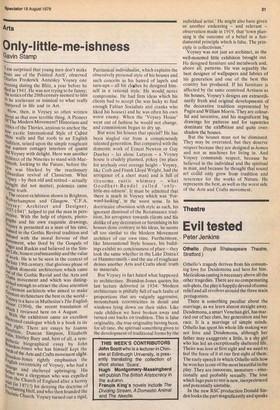Only-little-me-ishness
avin Stamp
lam surprised that young men don't make raore use of the Pointed Arch', observed Qharles Frederick Annesley Voysey one ening during the Blitz, a year before he ed in 1941. He was not trying to be funny; the antics of the 20th century seemed to him to be irrelevant or inimical to what really lhattered in life and in Art, How, then, is Voysey so often written ar,bout as that now terrible thing, A Pioneer uf The Modern Movement? Historians and critics of the Thirties, anxious to anchor the Ile,vv exotic International Style of Cu.bist woite walls and flat roofs to an English tradition, seized upon the simple roughcast d austere cottagey interiors of quaint 13'cl Voysey with delight. Here was another ,tect of the Nineties to stand with Mac"'Nosh, looking to the Future, before the 't,eW was blocked by the reactionary vuWardian revival of Classicism. What thqsey — by then old and retired — actually Ought did not matter; polemics came efore truth. The recent exhibition shown in Brighton, \\\:olverhampton and Glasgow, `C.F.A. 114°Ysey: Architect and Designer, ,J7-1941', helped to put the man in pers1:.ctive. With the help of objects, photoV4Phs and his own exquisite drawings, tpnYsey is presented as a man of his time, ilined in the Gothic Revival tradition and "bned with the moral fervour of that iii,invement, who lived by the Gospels of 418in and Ruskin and believed in the Sim0,e Life, honest craftsmanship and the value t," Work. He is to be seen in the context of late 19th century, that glorious phase of onglish domestic architecture which came elit Of the Gothic Revial and the Arts and wr4fts movement and which was distingmisi, 0, aed enough to attract the close attention 6` German architects who aimed to make verMan architecture the best in; the world — 4A°Ysey is a hero in Muthesius's The English 1,11V48e (1904), the recent translation of \V. I reviewed here on 4 August. rth the exhibition came an excellent "strated catalogue which is a book in its own , lie right. There are essays by Joanna Asis.eitine, Duncan Simpson, Elizabeth Patin, Shirley Bury and, best of all, a symkahetic biographical essay by John torndon-Jones who has himself kept the treill of the Arts and Crafts movement alight. 41an.don-Jones rightly emphasises the strgnsh eccentricity of Voysey, who had a tnge and sheltered upbringing. His fr,s'uor was a clergyman who was expelled urn the Church of England after a heresy trial 6 for denying the doctrine of n 18710 Iheistic Church. Voysey turned out a rigid, Puritanical individualist, which explains the obsessively personal style of his houses and such conceits as his hatred of lapels and turn-ups — all his cloihes he designed himself in a rational style. He would, never compromise. He had firm ideas which his ,clients had to accept (he was lucky to find enough Fabian Socialists and cranks who liked his houses) and he was often his own worst enemy. When the 'Voysey House' went out of fashion he would not change, and commissions began to dry up. But were his houses that special? He has been singled out from a conspicuously talented generation. But compared with the domestic work of Ernest Newton or Guy Dawber — let alone Lutyens — a Voysey house is crudely planned, pokey (no place for anybody over average height — Voysey, like Corb and Frank Lloyd Wright, had the arrogance of a short man) and is full of tiresome rustic whimsey — what Goodhart-Rendel called 'onlylittle-me-ishness'. It must be admitted that there is much in Voysey which was 'Forward-looking', in the worst sense. In his doctrinaire obsession with style as such, his ignorant dismissal of the Renaissance tradition, his arrogance towards clients and his dislike of any decoration or furnishing in his houses done contrary to his ideas, he seems all too similai to the Modern Movement architect of our own time. Furthermore, like International Style houses, his buildings exhibit no conciousness of place — they look the same whether in the Lake District, or Hammersmith — and the use of roughcast denies another Arts and Crafts ideal: truth to materials.
But Voysey in fact hated what happened to architecture. Brandon-Jones quotes his last lecture delivered in 1934: 'Modern architecture is pitifully full of such faults of proportions that are vulgarly aggressive, mountebank eccentricities in detail and windows lying down on their sides. Like rude children we have broken away and turned our backs on tradition. This is false originality, the true originality having been, for all time, the spiritual something given to the development of traditional forms by the individual artist.' He might also have given us another endearing — and relevant — observation made in 1919, that 'town planning is the outcome of a belief in a fundamental principle which is false. The principle is collectivism.' Voysey was not just an architect, as the well-mounted little exhibition brought out. He designed furniture and metalwork and, above all, patterns. He was arguably the best designer of wallpapers and fabrics of his generation and one of the best this country has produced. If his furniture is affected by the same contrived Artiness as his houses, Voysey's designs are extraordinarily fresh and original developments of the decorative tradition represented by Pugin and William Morris. They are colourful and inventive, and his magnificent big drawings for patterns and for tapestries dominate the exhitition and quite overshadow the houses.
But the houses must not be dismissed. They may be overrated, but they deserve respect because they are designed as homes and not as machines for living in. And Voysey commands respect, because he believed in the individual and the spiritual in man, and because he thought that sound art cotild only grow from tradition and reverence for the works of Nature. He represents the best, as well as the worst side of the Arts and Crafts movement.






























 Previous page
Previous page